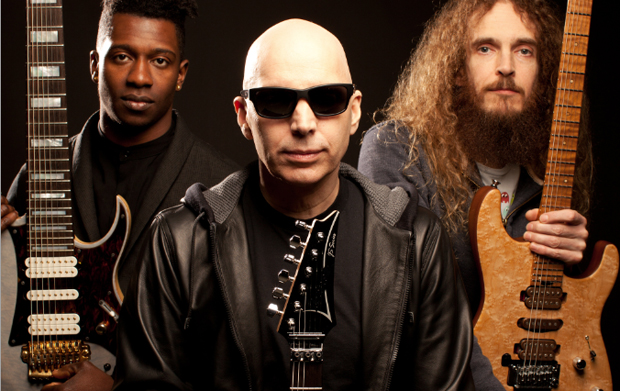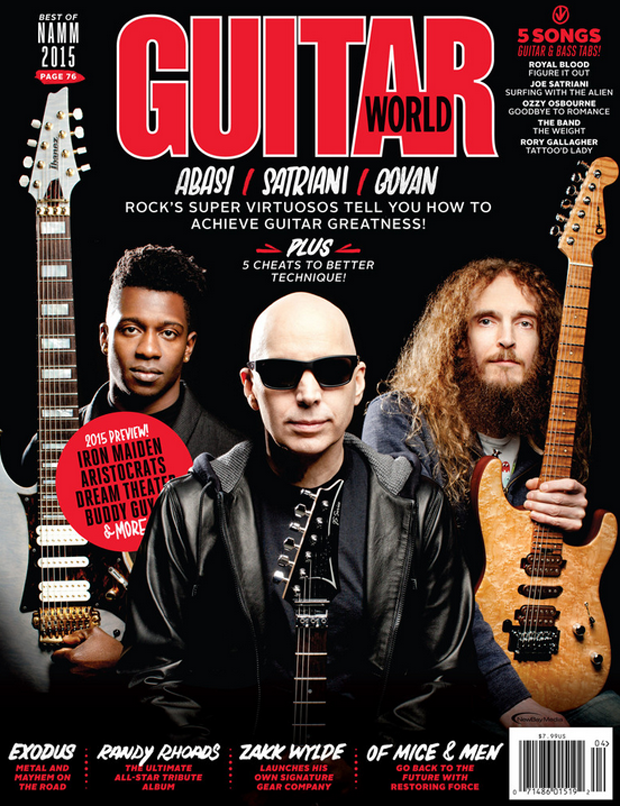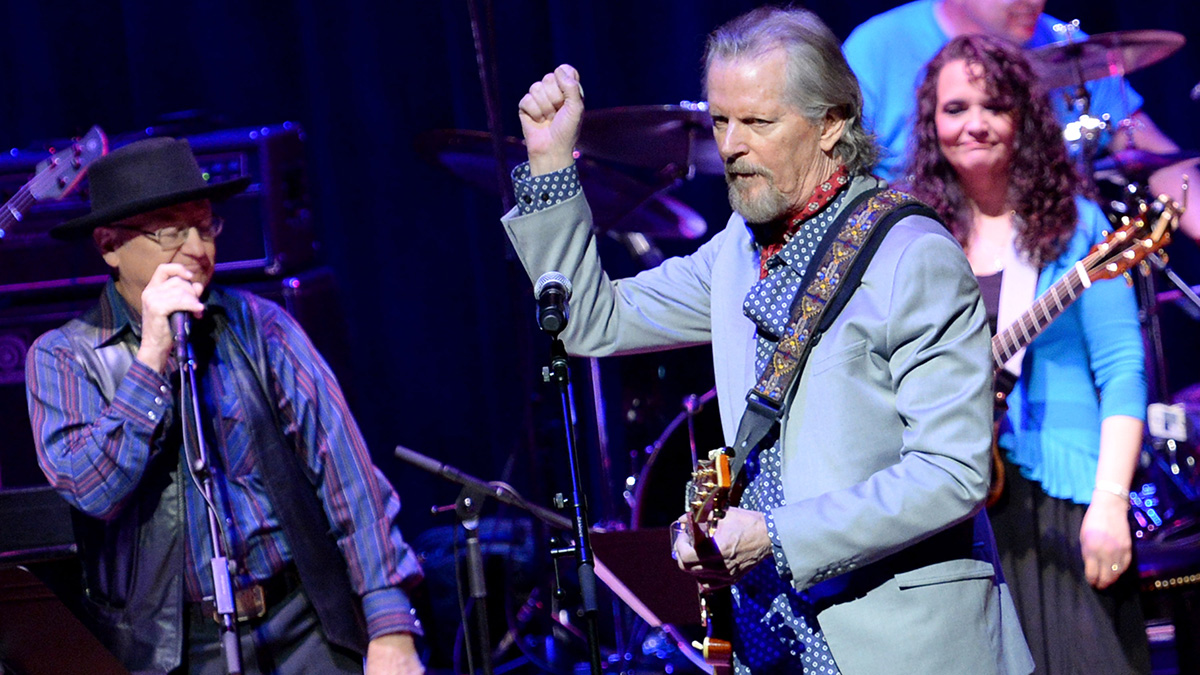Joe Satriani, Tosin Abasi and Guthrie Govan Join Forces for 2015 G4 Experience — Video

This is an excerpt from the April 2015 issue of Guitar World. For the complete interview, plus new-album previews from Joe Satriani, Guthrie Govan, Dream Theater, Megadeth, Warren Haynes and more, check out the April issue at the Guitar World Online Store.
Seated across from one another in a cavernous, chilly San Francisco photo studio, Tosin Abasi and Guthrie Govan are deep in conversation, dissecting and debating the relative merits of various guitar neck tone woods.
They’re both clearly attuned to the same profound level of guitar geekery—fretboard brothers. But it’s hard to imagine two human beings more different in appearance.
Abasi is impeccably and stylishly dressed in head-to-toe black, including a well-cut jacket that’s the handiwork of his sibling, the fashion designer Abdul Abasi. His hair is styled with razor-sharp precision in a kind of asymmetrical, post-modern pompadour.
Tosin’s professorial, tortoise rim eyeglasses lay primly on the table before him. His body language is angular and precise. He’s been pumping some iron of late…as if the dazzling virtuosity and abstract intensity of his eight-string guitar work with Animals as Leaders weren’t enough of an athletic accomplishment.
Thin, wiry and slumped in a leather chair across from Abasi, Guthrie Govan is sporting a rumpled Pac-Man T-shirt that looks as if he’s slept in it. His abundant nut-brown hair and scraggly beard appear not to have known the benefit of comb, brush or even shampoo in quite some time. He’s just off the plane from London, but looks as if he might just as well have tumbled out of a time machine, transported from some grotty, early-Seventies Jethro Tull lineup into the 21st Century technopolis that is San Francisco.
But the quietly understated wit and careful creativity with which he chooses his words belie his bedraggled appearance. The same strange mixture of offhand nonchalance, well-crafted mastery, retro rock references and fast-forward futurism distinguishes Govan’s exemplary guitar work with the Aristocrats, not to mention his solo discs and sideman work with Steven Wilson, Asia and others.
Mahogany versus wenge has become the conversation’s focal point when Joe Satriani enters the room. Like Abasi, he’s all in black, albeit in a more casual way—the timeless rock and roll uniform of T-shirt, jeans and leather jacket. Satch pulls a black watch cap off his clean shaven cranium and takes a seat alongside his fellow guitar titans. His quiet humility and air of mature reserve contrast benignly with the youthful exuberance of his cohorts.
Tosin Abasi and Guthrie Govan are both very much the children of Joe Satriani. Wildly disparate as they are in their musical and personal styles, Animals as Leaders and the Aristocrats could never have come into existence, let alone find a dedicated and enthusiastic audience, had Satriani not blazed a bold new trail in rock guitar playing in the Eighties—raising the bar for fretboard technique and making the world safe for shred.
And now Satriani, Abasi and Govan are joining forces with fellow guitarist Mike Keneally (Frank Zappa, Steve Vai, Joe Satriani, Henry Kaiser) and Dreamcatcher Events to present the second annual G4 Experience, a four-day, immersive guitar camp held in the idyllic environs of the Cambria Pines Lodge in California, June 28 to July 2.
Satch, Tosin, Guthrie and Mike will be joined by Govan’s fellow Aristocrats who also serve, conveniently enough, as Satriani’s current rhythm section. And, along with performances by Animals as Leaders, auxiliary instructors include bassist Stu Hamm and Guitar World’s own Andy Aledort as well as other special guests. The four-day musical retreat will include both concert performances and ad hoc jams as well as up-close and personal instruction from the four guitar stars and their guests.
The camp concept is very much Satriani’s brainchild, an offshoot of his much beloved G3 and G4 road tours.
“I thought it would be nice if there were some way to get away from the folding chair and PowerPoint presentation vibe behind most clinics,” Satriani says.
“Rather than just playing and teaching licks, I wanted to do something that mirrors my experience with the G3 tours. That’s where I see more rapt attention and people getting involved passionately, as concertgoers tend to do. I don’t really see that at clinics. So I was looking for a way to get the juicy fun of a live performance into a clinic situation. And that’s basically what I put to the Dreamcatcher Events guys who came to me with this idea of doing some kind of clinic over a period of days.”
For more about the 2015 G4 Experience, visit g4experience.com.
The first question is for Guthrie and Tosin. What was your initial reaction like when you were approached to take part in this instructional camp?
GUTHRIE GOVAN
The logical thing to do when approached by Joe Satriani and asked to do something like this is to say yes. In no way was it a difficult decision. Based on my experience with guitar camps, it always turns out to be an extension of the personality of the guy who dreamed it up in the first place. So I’m really looking forward to this one. It looks like it’s going to be a real musical experience, as opposed to a parade of circus tricks.
JOE SATRIANI
Although we’re not beneath that! [laugher] That’s kind of what we do in a way. Let me just say there’s nothing wrong with that. I’ve often said in clinics that everything is equal. All scales are equal. All chords are equal. It’s really all the same. It’s just a question of when and how to use them.
TOSIN ABASI
I’ve done clinics myself. My band did something similar to this—a camp setting where we had multiple days with the students. And while the instruction sessions are really cool, what can be even cooler is what happens outside the formal clinics: Students getting together with other students and sharing the ideas they just learned. There’s this really cool “behind the scenes” element. Bands form. Musical relationships are formed. Just having like-minded musicians all together in the same place, sharing the same information—it will be cool to facilitate that kind of interaction.
So what can people who take part in the camp expect to experience?
SATRIANI
I’m gonna play, I’m gonna talk and just take questions. I’m not going to make people pick up the guitar and say, “Put the third finger on the third fret.” It’s not gonna be like that. People will have a chance to observe me up close and ask questions. I think that’s the best way. There’s nothing like watching a guy do it. And this is one of the few times I won’t have to perform. I’m not gonna jump around. I’m gonna sit there and actually look at my guitar, and I can stand near my amp, which is cool! So that way, you can watch what I do. And if you see something weird, you can ask me about it and I’ll explain it in an honest way.
GOVAN
That approach gets my vote as well. The people who are attending will get a more personal experience. We can listen to them and bounce back on whatever they turn out to be looking for…rather than turning up with a prescribed list of what we think they need to know. It’s better to be flexible.
ABASI
I go with that too. It allows for an organic process that keeps unfolding, as opposed to predetermining which way it’s gonna go. And I think what Joe said about just watching is huge. There’s a cognitive level of understanding you get from watching people who have been playing guitar professionally for decades and have gotten to this high level of artistry. If you were to verbalize it, it wouldn’t be the same. To watch a guy like Guthrie, it’s not the same as watching a two-dimensional video screen. I can actually get close enough to see and hear how hard he’s picking! I think that level of instruction is invaluable.
In Carlos Santana’s autobiography, The Universal Tone, he talks about how players he admired in Mexico when he was coming up never showed him anything, “They showed me their back,” he says, and that this a tradition he and others still really respect. “I have my chops, go find yours.” So the question becomes, does a learning situation like a clinic compromise a player’s originality? Is there any value in finding your own chops?
GOVAN
I think that was more showmanship than anything else. You can create a mystique for yourself by pretending that a lick you do is so special that you have to hide it from people. Now more than ever people are going to figure out what you’re doing, whether you’re going to share it with them or not.
SATRIANI
When I was growing up you had to find somebody to show you how to play the way you wanted to play. There weren’t instructional videocassettes, let alone YouTube. But yeah, that’s a funny attitude, “I have my chops, go find yours.” I never understood that. That’s not the reality of the modern world. I don’t think people even worry about that.
ABASI
I agree, it does seem a little fear based. I think inspiration is what drove all of us to pick up a guitar. And inspiration comes from other guitarists, usually. There’s a fine line between emulation and originality. I might try real hard to emulate something and fail, but all of a sudden I’ve got something that’s my own version of it. There are so many ways to approach it.
Okay, so now the question becomes, what has the viral availability of information on technique and things like that done for the art of guitar playing?
SATRIANI
It’s definitely elevated it to an incredible level, and here’s the proof right here. Look at these guys! When I started playing, most people played the same, I would say. Six strings. Fenders and Gibsons. Really. There weren’t that many artists. How many pedals were there? Some of the music may have been complicated, but the tools weren’t so great. So people weren’t trying to do much with the guitar. But now the art of guitar playing has been elevated to an incredible level. Look at Tosin and Guthrie here—or someone like Charlie Hunter—and you think, Oh my God, what happened? The future is here. And all that other music is still available too. You can go on YouTube and see a 14-year-old kid who sounds like one of the blues artists from back then.
ABASI
The prevalence of all this information has brought a real cool evolution in guitar playing, but it also creates a sense of overload. Like for me, I would get one instructional video, devour it and then I’d have to go to the music store physically, pick out another and take that home. Now it’s like you can Google “melodic minor” and it’s this tremendous rabbit hole that, for me personally, can get a little overwhelming. The information is so accessible and so vast. But that’s why things like this camp are so important. Yes, all this information is now available, but what you’re going to get from us is more of a specialized, individual actual representation of all this information. How we express ourselves on the guitar. And I think that will help channel out all the distractions that can come from all the information out there.
This is an excerpt from the April 2015 issue of Guitar World. For the complete interview, plus new-album previews from Joe Satriani, Guthrie Govan, Dream Theater, Megadeth, Warren Haynes and more, check out the April issue at the Guitar World Online Store.
Photo: Justin Borucki

Get The Pick Newsletter
All the latest guitar news, interviews, lessons, reviews, deals and more, direct to your inbox!
In a career that spans five decades, Alan di Perna has written for pretty much every magazine in the world with the word “guitar” in its title, as well as other prestigious outlets such as Rolling Stone, Billboard, Creem, Player, Classic Rock, Musician, Future Music, Keyboard, grammy.com and reverb.com. He is author of Guitar Masters: Intimate Portraits, Green Day: The Ultimate Unauthorized History and co-author of Play It Loud: An Epic History of the Sound Style and Revolution of the Electric Guitar. The latter became the inspiration for the Metropolitan Museum of Art/Rock and Roll Hall of Fame exhibition “Play It Loud: Instruments of Rock and Roll.” As a professional guitarist/keyboardist/multi-instrumentalist, Alan has worked with recording artists Brianna Lea Pruett, Fawn Wood, Brenda McMorrow, Sat Kartar and Shox Lumania.
“The guitar is the instrument of the people”: The IGF Summer School celebrates 30 years of levelling up guitar players with a bumper Bath event
These are the gear trends that will shape your guitar buying in 2025: we explored every inch of NAMM to discover what brands are plotting for the next 12 months – and how the guitar gear world at large is changing

